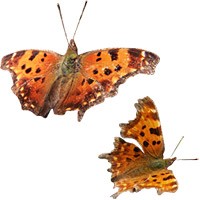
Butterfly researchers come to Fermilab for rare species
Scientists usually search Fermilab for exotic particles, but two Alabama researchers recently sought another rarity—a butterfly called the Gray Comma.
The woodland butterfly with the comma-shaped marking under its wing was one of the last 10 butterfly species Paulette Haywood and Sara Bright needed to complete a book about the 125 butterfly species of the Southeastern United States. The pair has worked on the book for 12 years.
“The Gray Comma would have been difficult to find and document in the Southeast,” says Haywood. “So for us to be able to come to Fermilab and knock another species off our list was huge.”
The researchers were drawn to the laboratory by a Web site, run by Technical Division engineer Tom Peterson, that documents Fermilab's natural setting and its butterfly population.
Peterson, who has watched butterflies at Fermilab for 31 years, was happy to point out the butterfly's habitat on the west side of the laboratory. “We've been careful, in our management of the land here at Fermilab, to restore it in a way that's friendly to nature,” he says. “And certainly that's reflected in the variety of butterflies, birds, and plants we find here.”
Haywood and Bright hope their book will help people understand how interconnected nature is and the importance of taking care of the environment. “People love to look at beautiful butterflies,” Haywood says. “But they have to understand that to see those beautiful butterflies, there have to be places like Fermilab for them to live and thrive.”
Amelia Williamson
Click here to download the pdf version of this article.






